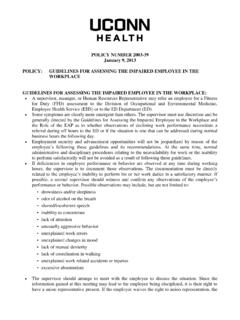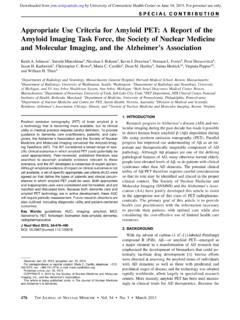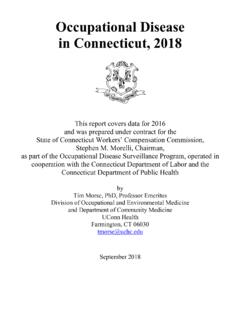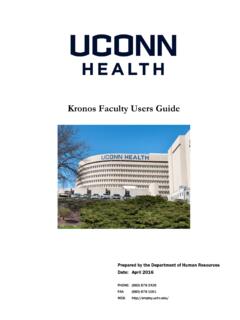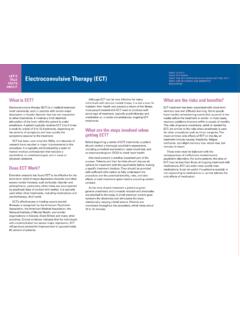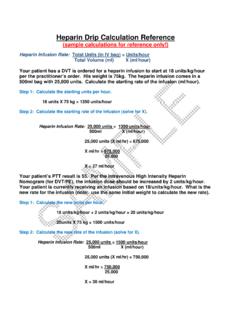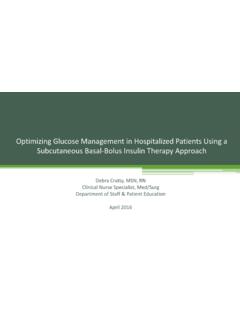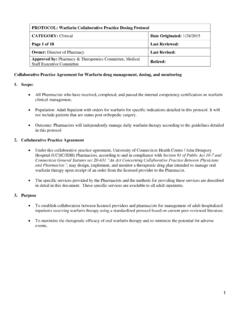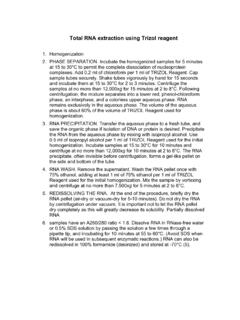Transcription of Guidance for Clinicians Recognition and Management and ...
1 Guidance for Clinicians on theRecognition and Management of Health Effects related to Mold Exposure and Moisture IndoorsEileen Storey, H. Dangman, Schenck, L. DeBernardo, S. Yang, Bracker, J. Hodgson, the Cover: Penicillium chrysogenum in culture. P. chrysogenum is a fungal speciescommonly found in water-damaged environments. (Image courtesy of Dr. De-wei Li of P&KMicrobiology Services, currently with the Connecticut Agricultural Experiment Station)iGuidance for Clinicians onthe Recognition andManagement of HealthEffects Related to MoldExposure and MoistureIndoorsEileen Storey MD MPHK enneth H. Dangman MD PhD MPHP aula Schenck MPHR obert L. DeBernardo MD MPHChin S. Yang PhDAnne Bracker CIH MPHM ichael J. Hodgson MD MPHU niversity of Connecticut Health CenterDivision of Occupational and Environmental MedicineCenter for Indoor Environments and Health263 Farmington AvenueFarmington, CT 06030-6210 September 30, 2004iiiiiThis publication was developed under Cooperative Agreement No.
2 T 981255 awarded by Environmental Protection Agency. EPA made comments and suggestions on the documentto improve the scientific analysis and technical accuracy of the document. However, the viewsexpressed in the document are those of the Division of Occupational and Environmental Medi-cine, Center for Indoor Environments and Health, University of Connecticut Health Center, andEPA does not endorse any products or commercial services mentioned in the authors graciously thank the US Environmental Protection Agency (EPA) for financialassistance that supported the Center for Indoor Environments and Health at the Universityof Connecticut Health Center to convene the authors to develop this Guidance for Clini-cians on the Recognition and Management of Health Effects Related to Mold Exposure andMoisture this instructional book posed challenges, and we were fortunate in having help withthe task from many individuals.
3 From the beginning of the development in mid-2000 throughproduction stages in 2004, Susan M. Conrath, PhD, MPH, MPhil, and Laura S. Kolb, MPH, fromEPA s Indoor Environments Division contributed helpful suggestions, shared their insight, andprovided a systematic review also wish to thank the outside reviewers who unselfishly gave their time and expertise toreview and comment on a draft document. In addition, we are indebted to the practitioners whoparticipated in focus groups that helped define the scope and form of this Guidance . With theassistance of the University of Connecticut School of Medicine Student Continuity Practice andthe Massachusetts Medical Society, focus group discussions provided information and feedbackthat informed the authors on specific areas of most concern in clinical are most grateful to our patients at the University of Connecticut Health Center Occupa-tional and Environmental Medicine Clinic.
4 Our special thanks go to those who graciously allowedus to profile their cases and who serve as important instructional examples for this book. Inaddition, we deeply thank our pediatrician colleague, Dr. Karen Daigle, for consulting with us onenvironmental considerations and for providing us the informative case description of the infantwith recurring respiratory important to the success of this project include Barbara Spark from EPA Region 9;MaryBeth Smuts, PhD, Lois K. Adams, MS, and Eugene Benoit, MA, MS, from EPA Region 1;and Polly Hoppin, ScD, for their key involvement in administrating this work. We are indebted toKathleen McDermott and Cheryl Steciak at the University of Connecticut Health Center forediting assistance and administrative support, and to The Cadmus Group, Inc.
5 For useful guidanceand help with the review process, final manuscript editing, and Web-based text of the individuals noted here contributed to the final quality of the document; however theauthors are solely responsible for the content of this photographs used in this document were provided by Chin S. Yang, , president ofP&K Microbiology Services, Introduction and Goals of this Book .. 1 Goals of the Book .. 12. Illustrative Clinical Experience .. 5 Case 1: A Middle School Teacher with Successive Respiratory 6 Clinical 6 Building 7 Resolution .. 7 Cases 2 and 3: Two Teachers in a Rural School That Was Plagued with Water Intrusion and Mold;Patient A Was Diagnosed with Sarcoidosis and Patient B with Occupational Asthma .. 7 Patient A Clinical 7A Sentinel Case Model.
6 8 Patient B Clinical 8 Environmental Assessment of the School .. 9 Case 4: An Office Worker Initially Seen for Upper Respiratory Symptoms and Work-related RashDeveloped Occupational Asthma after Serial Exposures to Mold in the Work Place .. 10 Clinical 10 Case 5: An Infant Treated for Serious Recurring Respiratory Illness Had Most Symptoms Resolvein Substantially Mold- and Moisture-free Environments.. 12 Clinical 123. About Fungus and 15 Fungi 16 Ecology and 16 Other Microbial Agents and 17 Reproduction and 18 Fungal Products .. 18 Specific 194. Health Effects of Fungi and 21 Fungal 22 Allergic and Hypersensitivity Reactions to Fungi .. 22 Allergic Rhinitis and Asthma .. 23viiiHypersensitivity Pneumonitis and other Interstitial Lung 25 Allergic Bronchopulmonary Aspergillosis and Allergic Fungal 25 Allergic Dermatitis.
7 26 Irritant Reactions to Fungal 26 Reactions to Mycotoxins .. 275. Recognition and Management of Mold- and Moisure-related Illness .. 32 Patients Whose Conditions Warrant an Environmental Assessment Because They AreFrequently Induced by Environmental Factors, Including Moisture and Mold .. 32 Patients with Common Symptoms That Have a Clear Temporal Relationship with SpecificPlaces .. 34 Patients Concerned over Perceived Exposure to Mold .. 35 General Clinical 36 Clinical Evaluation Relative to the 36 Evaluation Tools .. 37 Management and Remediation .. 40 Medical Management and 40 Environmental 436. Environmental 45 Consultant Selection and Staff Training .. 46 Industrial Hygienists .. 47 Indoor Environmental Quality (IEQ) 47 Environmental Health 48 Patient or Family Member as Investigator of Environment.
8 48 Qualitative Approach to Environmental Site 48 Interview and Walk-through 48 Focused Qualitative Assessment .. 49 Ventilation System Review .. 49 Ventilation in Homes .. 51 Summary of Qualitative 51 Sampling and Analysis .. 52 Source Sampling and Microscopic 53 Bulk and Settled Dust Sampling and Microbial 53 Air Sampling .. 53 Limitations and Difficulties with Mold Concentration 54 Interpretation of Air-sampling Data .. 54 Additional Quantitative 557. Environmental Remediation Guidance ..57 Step Approach to 57ixStep 1: Mitigate Moisture Incursion into the Home or Work 57 Step 2: Maintain Low Indoor 57 Step 3: Clean or Remove Mold-damaged Building Materials, Furnishings, and Other Items .. 57 Protection While Removing or Cleaning Mold-contaminated Materials.
9 58 Indoor Air Quality During 588. 61 Appendix A: A Short Description of Selected Molds and Summary Charts on Sampling andAnalysis for Fungi in the Indoor A-1A Short Description of Selected Molds .. A-1 Summary Charts on Sampling and Analysis for Fungi in the Indoor Environment .. A-5 Appendix A References .. A-7 Appendix B: Health Effects; Reactions to B-1 Background on Assessing Toxicity Risk .. B-2 Toxicity from Ingestion of B-3 Toxicity from Effects of Parenteral Exposure to B-5 Effects of Inhaled B-5 Stachybotrys chartarum, a Discussion of the Current B-6 Summary and Conclusions on Effects of B-10 Appendix B References .. B-12 Appendix C: Evaluating Patients For The Presence of Specific Antibodies to Molds .. C-1 Hypersensitivity Pneumonitis (HP) Antibody Screen.
10 C-1 Appendix C References .. C-2 Appendix D: Recognition and Management of Mold-related D-1An Algorithm for the Healthcare Provider s Office .. D-1 Table A: Sentinel D-2 Table B: Questions for Patients with Common D-3 Table C: Environmental Questionnaire (For Patients with Sentinel Conditions, Symptoms thatVary by Environment, or a History of Recurrent Moisture Incursion).. D-4 Table D: Current Symptoms - History and Relationship to Home, Work, or School (For Patientsin Which a Potential Exposure to Mold Exists) .. D-6 Table E: Environment Intervention Guidance (Selected World Wide Web Resources) .. D-7x11. Introduction and Goals of this BookPatients present to pri-mary care services withsymptoms and healthconcerns that require consider-ation of environmental some cases, patients exposure to molds in theirhomes, offices, schools, andworkplaces may be having asignificant effect.
